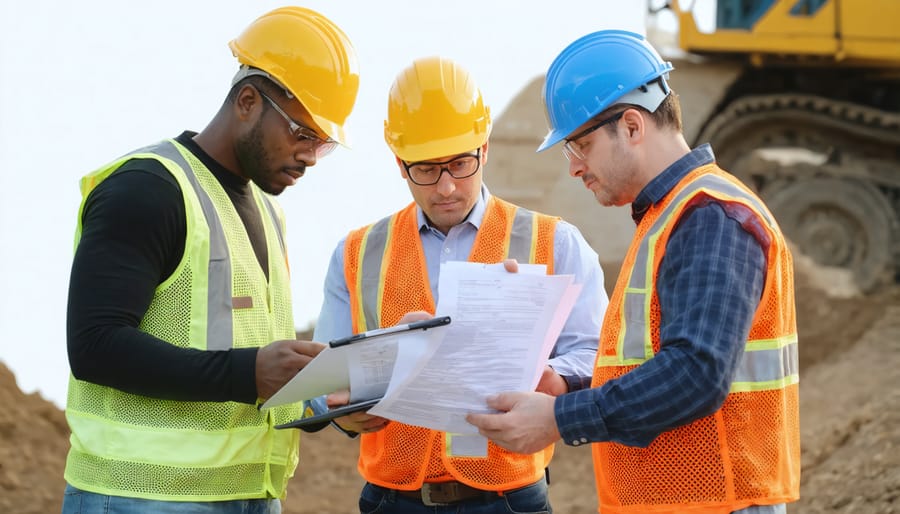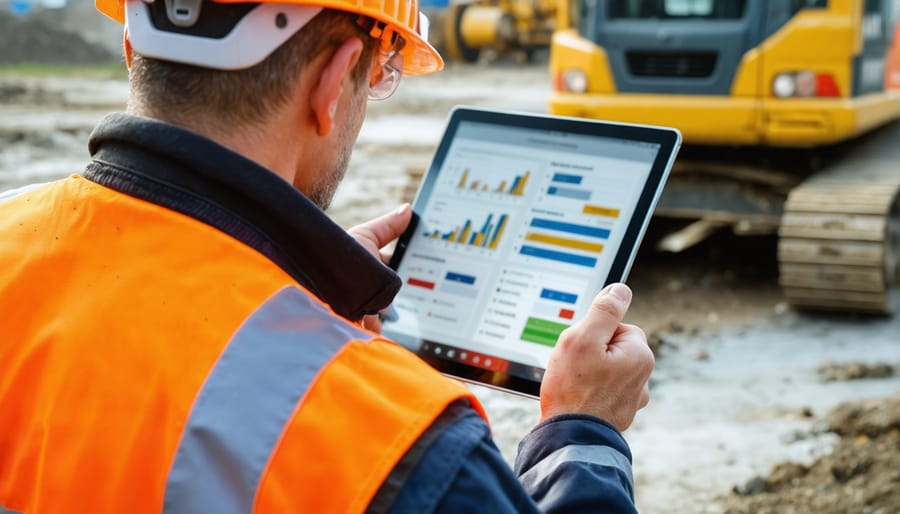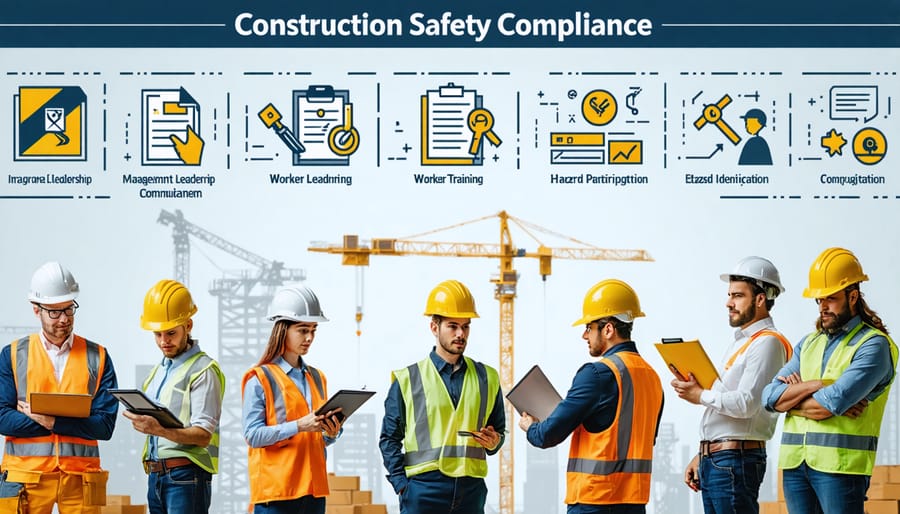In today’s high-stakes construction environment, mastering safety compliance isn’t optional—it’s imperative for project success and workforce protection. The seven fundamental compliance elements form the backbone of every effective construction safety program, directly impacting project outcomes, worker well-being, and organizational sustainability. Recent industry data reveals that companies implementing all seven elements experience 48% fewer safety incidents and save an average of $3.2 million annually in prevented losses. These interconnected components—management leadership, worker participation, hazard identification, hazard prevention, education and training, program evaluation, and communication—create a comprehensive framework that transforms theoretical safety principles into practical, measurable results. Whether you’re revamping an existing safety program or building one from the ground up, understanding and implementing these seven elements will ensure your organization meets regulatory requirements while fostering a culture of safety excellence.
Written Health and Safety Policies

Policy Development and Documentation
Effective policy development forms the foundation of any successful safety compliance program. Organizations must establish clear, written policies that align with OSHA construction regulations while addressing site-specific safety concerns. These policies should outline specific procedures, responsibilities, and expectations for all personnel involved in construction operations.
Documentation must be comprehensive, current, and easily accessible. Key components include detailed safety procedures, risk assessments, incident reporting protocols, and emergency response plans. Regular policy reviews and updates are essential to ensure continued relevance and effectiveness as regulations and industry best practices evolve.
Maintain organized records of safety meetings, training sessions, inspections, and incident investigations. Electronic documentation systems can streamline this process while ensuring proper version control and accessibility. Include templates and standardized forms to promote consistency in reporting and documentation across all project sites.
Remember that policies should be practical and implementable rather than merely theoretical. Involve key stakeholders in policy development to ensure procedures reflect real-world conditions and operational requirements while maintaining compliance standards.

Safety Training and Education Programs
Training Implementation and Tracking
Effective training implementation requires a structured approach combining various delivery methods and robust tracking systems. Construction companies should utilize a blend of classroom instruction, hands-on demonstrations, and digital learning platforms to accommodate different learning styles and ensure comprehensive knowledge retention.
Training programs must be documented through detailed records that include attendance logs, completion certificates, and competency assessments. Modern tracking systems, such as learning management software (LMS), enable real-time monitoring of employee progress and automatic notification of certification renewals or required refresher courses.
To maintain compliance, establish a regular training schedule that addresses both mandatory safety requirements and site-specific hazards. Implementation should include pre-job safety briefings, toolbox talks, and periodic skill assessments. Performance metrics should track completion rates, assessment scores, and incident rates to evaluate training effectiveness.
Consider incorporating mobile applications and QR-coded safety materials for easy access to training resources in the field. Regular audits of training records and delivery methods ensure the program remains current with industry standards and regulatory requirements. Update training materials based on incident investigations, new equipment introductions, and changing workplace conditions.
Hazard Identification and Risk Assessment
Risk Assessment Tools and Techniques
Several proven tools and techniques are essential for conducting thorough risk assessments in construction projects. Job Safety Analysis (JSA) matrices help identify task-specific hazards and establish appropriate control measures. These detailed breakdowns evaluate each work phase, considering potential risks and their likelihood of occurrence.
Hazard identification checklists serve as comprehensive guides, ensuring no critical safety aspects are overlooked. These standardized tools cover everything from fall protection to electrical safety, providing a systematic approach to risk evaluation.
Digital risk assessment platforms have become increasingly valuable, offering real-time data collection and analysis capabilities. These systems often include mobile applications for field inspections, automated reporting features, and trend analysis tools that help identify recurring safety concerns.
Quantitative risk assessment methods, such as the Fine-Kinney method, provide numerical evaluations of risk levels by considering probability, exposure, and potential consequences. This data-driven approach helps prioritize risk mitigation efforts and allocate resources effectively.
Regular safety audits and inspections, supported by photographic documentation and detailed reporting templates, complete the risk assessment toolkit, ensuring continuous monitoring and improvement of safety measures.

Incident Reporting and Investigation
Effective incident reporting and investigation systems form a critical foundation for maintaining workplace safety and preventing future accidents. These systems should encompass both near-misses and actual incidents, as each provides valuable insights into potential hazards and areas requiring improvement.
A robust incident reporting system should feature clear protocols for immediate notification, standardized reporting forms, and designated personnel responsible for managing reports. Construction firms must ensure that workers feel comfortable reporting incidents without fear of reprisal, fostering a culture of open communication and continuous improvement.
The investigation process should follow a structured methodology, including:
– Securing the incident scene
– Collecting physical evidence
– Interviewing witnesses
– Analyzing root causes
– Developing corrective actions
– Implementing preventive measures
Digital incident management systems have become increasingly important, allowing for real-time reporting, efficient documentation, and trend analysis. These platforms help organizations track incident patterns, measure safety performance, and identify areas requiring additional training or resource allocation.
Learning from incidents is paramount. Regular safety meetings should include discussions of recent incidents and near-misses, sharing lessons learned across project sites. This information should inform updates to safety protocols, training programs, and risk assessments, creating a cycle of continuous improvement in workplace safety practices.
Emergency Response Planning
Emergency response planning is a critical component of construction safety compliance that requires thorough preparation and regular updates. A comprehensive emergency response plan must address various potential scenarios, including fires, structural collapses, severe weather events, and medical emergencies.
The foundation of effective emergency response planning lies in conducting detailed site-specific risk assessments. These assessments help identify potential hazards and determine appropriate response protocols. Key elements include establishing clear evacuation routes, designating assembly points, and maintaining up-to-date emergency contact information for all relevant authorities and stakeholders.
Construction sites must maintain readily accessible emergency equipment, including first-aid kits, fire extinguishers, and communication devices. Regular inspection and maintenance of this equipment are essential to ensure functionality during emergencies. Emergency response teams should be appointed and trained in their specific roles, with clear chains of command established for different types of emergencies.
Documentation and communication are vital aspects of emergency planning. Written procedures should be readily available, and all workers must be familiar with emergency protocols through regular training and drills. These drills should simulate various emergency scenarios to test response effectiveness and identify areas for improvement.
Post-incident analysis is equally important, as it helps refine emergency procedures based on real-world experiences. This continuous improvement approach ensures that emergency response plans remain current and effective, adapting to changing site conditions and emerging risks.
Regular Safety Inspections and Audits
Regular safety inspections and audits form the backbone of an effective compliance program, requiring systematic evaluation of workplace conditions, practices, and documentation. Construction organizations should establish a structured inspection schedule that includes daily walkthrough assessments, weekly equipment checks, and comprehensive monthly audits. These inspections must be documented using standardized checklists and digital compliance tools to ensure consistency and trackability.
Key inspection areas should include personal protective equipment (PPE) usage, fall protection systems, scaffolding integrity, electrical safety, and emergency response readiness. Qualified safety professionals should lead these assessments, accompanied by site supervisors and worker representatives to provide diverse perspectives on potential hazards.
Third-party audits conducted annually offer an objective evaluation of compliance performance and help identify systemic issues that may be overlooked during routine inspections. Follow-up procedures must be established to address identified deficiencies, with clear timelines for corrective actions and verification protocols to ensure implementation effectiveness.
Documentation and Record Keeping
Proper documentation and record keeping form the cornerstone of an effective safety compliance program. Construction companies must maintain detailed records of safety training sessions, incident reports, equipment inspections, and hazard assessments. These records serve as crucial evidence of compliance and provide valuable data for improving safety protocols.
Essential documentation includes OSHA-required forms, safety meeting minutes, training certificates, and equipment maintenance logs. All records should be organized systematically and stored securely, with both physical and digital copies when possible. Companies must retain these documents for the mandated periods, which vary by record type but typically range from three to thirty years.
Regular audits of documentation systems help ensure completeness and accuracy. Implement a standardized filing system that allows quick access to records during inspections or investigations. Key personnel should be trained in proper documentation procedures, including date stamping, signature requirements, and electronic filing protocols.
Modern safety management software can streamline record keeping, offering features like automated reminders for updates, digital form completion, and cloud storage solutions. This technology enables better tracking and analysis of safety trends while ensuring regulatory compliance.
The successful implementation of all seven compliance elements creates a robust foundation for workplace safety that extends beyond mere regulatory adherence. When working in harmony, these elements form an integrated system that significantly reduces workplace incidents, enhances operational efficiency, and fosters a culture of safety excellence. Organizations that diligently apply these elements typically experience improved employee engagement, reduced insurance costs, and enhanced reputation within the industry. By maintaining consistent focus on documentation, training, hazard assessment, emergency preparedness, communication protocols, regular audits, and continuous improvement, construction companies create a comprehensive safety framework that protects both their workforce and their bottom line. The synergistic effect of these elements working together ultimately leads to sustainable safety performance and operational excellence, making them essential components of any successful construction safety program.

